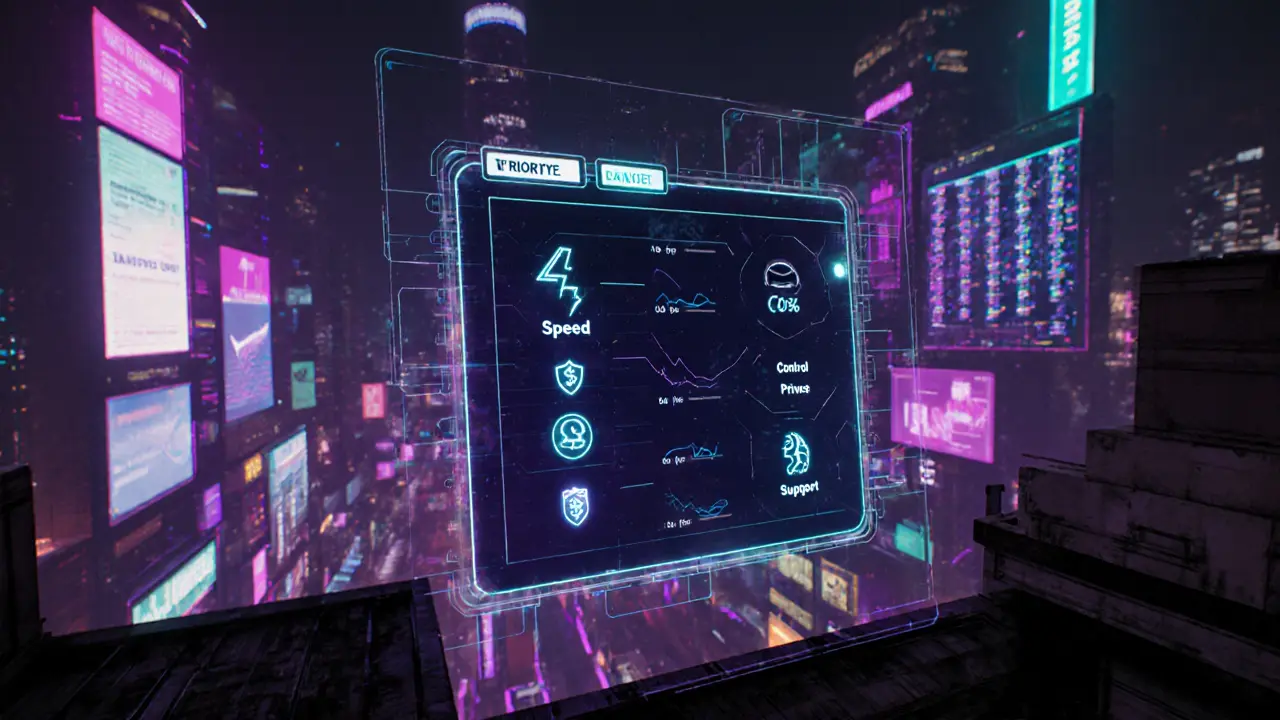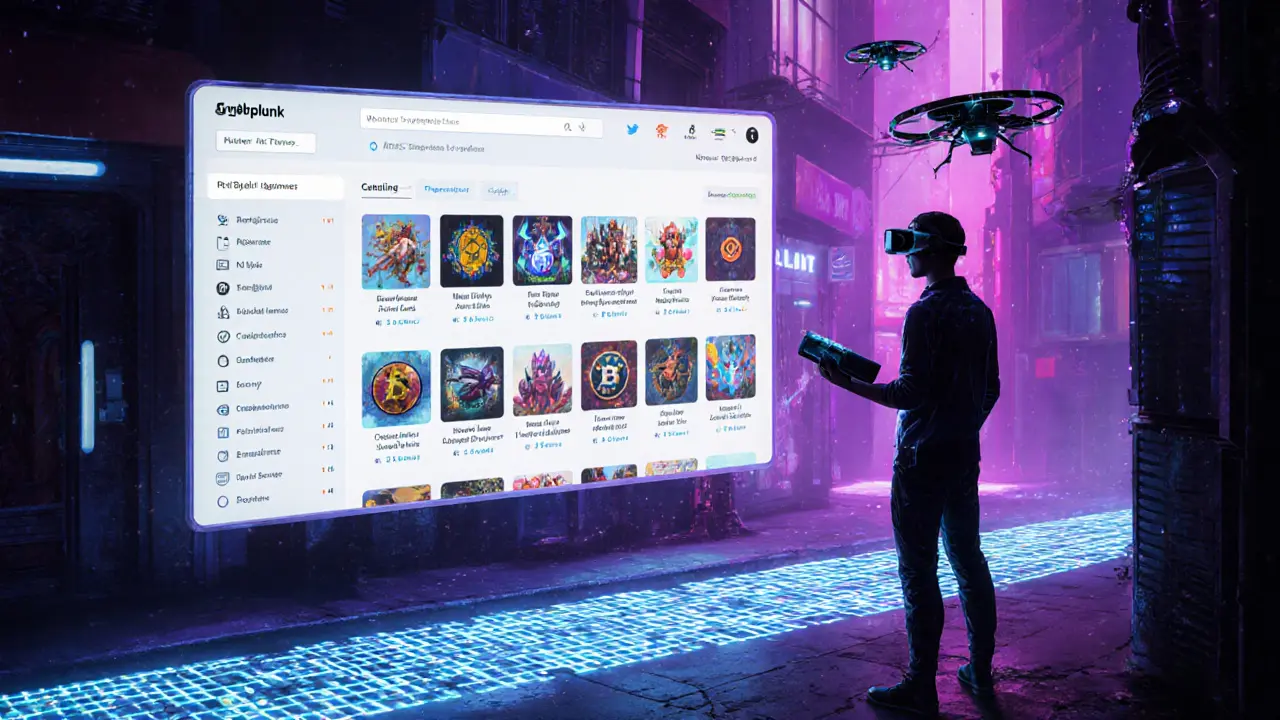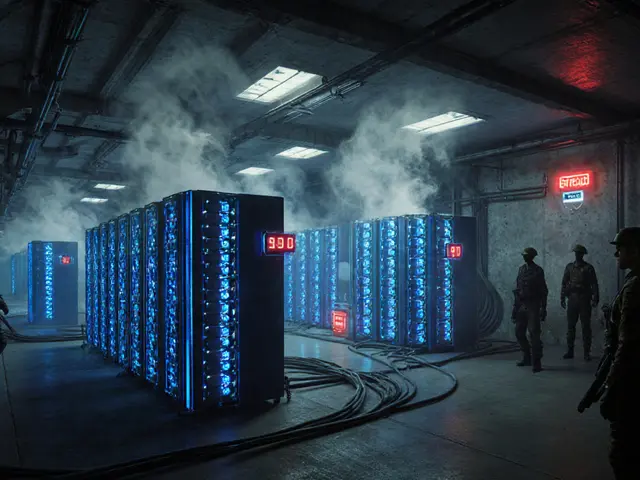NFT Marketplace Comparison Tool
Use this tool to compare centralized and decentralized NFT marketplaces based on key criteria. Select your priorities to see which option suits your needs best.
Controlled by a single company with optimized performance and user-friendly features.
- ✅ Fast transactions (sub-minute)
- ✅ User-friendly interface
- ✅ Customer support available
- ❌ Platform can ban users
- ❌ Requires KYC verification
Peer-to-peer trading with no central authority controlling assets.
- ✅ Full asset control
- ✅ Transparent fee structure
- ✅ Pseudo-anonymous trading
- ❌ Requires technical knowledge
- ❌ Gas fees apply to every transaction
Select Your Priorities:
Comparison Results:
| Aspect | Centralized | Decentralized |
|---|---|---|
| Transaction Speed | ✅ Sub-minute | ⏳ Depends on blockchain |
| Fees | 💸 0.1-0.25% | 💰 0.05-0.1% |
| Asset Control | ❌ Platform holds assets | ✅ You own keys |
| Privacy | ❌ KYC required | ✅ Pseudo-anonymous |
| User Experience | ✅ Intuitive UI | ⚠️ Requires wallet knowledge |
| Security Risk | ⚠️ Single point of failure | ⚠️ Smart contract bugs |
Select your priorities above to receive personalized recommendations on whether a centralized or decentralized marketplace suits your needs better.
Trying to figure out whether you should list your next crypto art on a traditional platform or a blockchain‑only hub? The debate between decentralized NFT marketplaces and their centralized cousins has sharpened as the NFT market exploded. Below we break down how each model works, where they excel, where they fall short, and how to decide which fits your goals.
What Is an NFT Marketplace?
NFT Marketplace is an online platform where non‑fungible tokens are bought, sold, and traded. It acts as a digital storefront, matching sellers with collectors and handling the transfer of ownership on a blockchain.
Centralized NFT Marketplaces
Centralized NFT Marketplace is a platform run by a single company that controls the user interface, transaction processing, and data storage. Examples include OpenSea is the world’s largest NFT marketplace, handling billions of dollars in sales through a proprietary backend and Coinbase NFT is a marketplace built on top of Coinbase’s exchange infrastructure, offering a familiar onboarding flow for fiat users.
These platforms work like a typical e‑commerce site. You create an account, link a wallet, and the marketplace’s servers confirm your trade within seconds. Because the company owns the matching engine, they can optimise latency, batch orders, and provide instant UI feedback.
- Speed: Transactions are confirmed in under a minute because the platform validates them off‑chain before broadcasting to the blockchain.
- Fees: Most charge a percentage‑based fee (0.1‑0.25%) plus optional listing costs.
- User experience: Built‑in customer support, fiat on‑ramps, and simple navigation lower the entry barrier.
Decentralized NFT Marketplaces
Decentralized NFT Marketplace is a peer‑to‑peer trading layer that lives directly on a blockchain, with no single entity controlling the order book or custody of assets. Notable projects include the on‑chain trading modules of The Sandbox is a virtual world that lets creators exchange land parcels via a fully on‑chain marketplace and community‑run protocols that leverage IPFS is a distributed file system that stores NFT metadata without a central server for off‑chain assets.
Here, the smart contract (a piece of Smart Contract is self‑executing code on a blockchain that enforces trade rules without intermediaries) acts as the market maker. When you click “Buy”, your wallet signs a transaction, pays the network’s gas fee, and the contract swaps ownership automatically.
- Control: You retain full custody of private keys; no platform can freeze or censor your assets.
- Fees: Typically a flat protocol fee (often 0.05‑0.1%) that is redistributed to liquidity providers or validators.
- Privacy: No mandatory KYC, allowing pseudo‑anonymous trades.

Head‑to‑Head Comparison
| Aspect | Centralized | Decentralized |
|---|---|---|
| Governance | Company‑driven policies, can ban users or NFTs. | Protocol‑wide rules enforced by code; community can fork. |
| Transaction Speed | Sub‑minute confirmations (off‑chain matching). | Depends on blockchain finality; usually a few minutes. |
| Fee Structure | 0.1‑0.25% + possible listing fees. | 0.05‑0.1% protocol fee, often shared with liquidity providers. |
| User Experience | Intuitive UI, fiat on‑ramps, customer support. | Requires wallet knowledge, gas fee management, limited support. |
| Security Model | Single point of failure; server breaches can affect all users. | Distributed nodes; attack surface is smart‑contract bugs. |
| Metadata Storage | Often on centralized CDNs; higher censorship risk. | Can use IPFS or Arweave for truly immutable storage. |
Key Trade‑offs You Should Weigh
Speed vs Decentralization - If you need instant order execution for high‑value drops, a centralized service’s off‑chain matching can make a difference. But the same speed comes with a trust trade‑off.
Cost vs Control - Central platforms charge higher fees, but they also absorb infrastructure costs and provide escrow mechanisms. Decentralized protocols keep fees low, yet you must manage gas spikes yourself.
Privacy vs Support - Want anonymity? Go decentralized and skip KYC. Prefer a help desk and dispute resolution? Centralized marketplaces excel.
Security Risks - Centralized systems are vulnerable to hacks that can drain user funds or expose data. Decentralized setups shift risk to smart‑contract bugs; a well‑audited contract is crucial.
Hybrid Models and the Future
Both camps are converging. Some projects launch a white‑label storefront that uses a central UI while routing trades through an on‑chain order‑book. Others adopt Blockchain is the distributed ledger that underpins NFTs and decentralized marketplaces‑native liquidity pools to improve depth without sacrificing user‑friendly design.
Improvements in IPFS is a peer‑to‑peer file system that can store NFT media and metadata in a decentralized way and the rise of “layer‑2” solutions (e.g., zk‑rollups) are reducing gas fees and confirmation times, making fully on‑chain experiences more practical for everyday users.
How to Choose the Right Marketplace for Your NFT
- Define your priority: Speed, cost, privacy, or support?
- Assess your technical comfort: If you’re comfortable managing private keys and gas, a decentralized protocol can save money.
- Check the community and liquidity: A platform with active buyers reduces slippage on large sales.
- Review metadata handling: Verify whether the artwork is stored on IPFS/Arweave or a proprietary CDN.
- Consider hybrid options: Look for marketplaces that offer a central UI but route trades on‑chain.
By walking through these steps you’ll land on a solution that aligns with both your short‑term launch goals and long‑term asset ownership philosophy.

Frequently Asked Questions
Can I sell NFTs on both centralized and decentralized platforms?
Yes. Most NFTs minted on a public blockchain are tradeable on any marketplace that supports the token standard (e.g., ERC‑721). You just need to connect a compatible wallet to each platform.
What are the main security concerns for decentralized marketplaces?
The biggest risk is a vulnerable smart contract. If a bug allows unauthorized token transfers, attackers can drain funds. Always look for audits from reputable firms before trading large sums.
Why does metadata storage matter?
Even if the token lives on a blockchain, the image or video is often hosted off‑chain. If that server goes down or the owner deletes the file, the NFT can become a broken link, reducing its value.
Do decentralized marketplaces charge any hidden fees?
The protocol fee is usually transparent, but you also pay network gas costs. During congestion, gas can spike dramatically, so budgeting for that extra expense is essential.
Is it possible to get customer support on a decentralized platform?
Support is community‑driven: forums, Discord channels, or GitHub issue trackers. Expect slower response times and no formal escrow, unlike the help desks on centralized services.





Comments
15 Comments
Cynthia Rice
In the grand theater of NFTs, the choice between a tyrant’s throne and a libertarian’s garden defines your artistic destiny.
Promise Usoh
While the dichotomy presents itself with apparent clarity, one must considere the underlying infrastructural implications that each platform engenders, lest the investor be blindsided by unanticipated costs.
Shaian Rawlins
I see both worlds as complementary pieces of a larger puzzle; centralized venues give newcomers a smooth onboarding experience, while decentralized platforms empower seasoned creators to retain sovereignty over their work. The ease of use on sites like OpenSea can lower barriers for artists unfamiliar with wallet management. However, the trade‑off is a relinquishment of absolute control, which may not sit well with those who cherish decentralization. On the other hand, mastering a wallet and handling gas fees opens up possibilities for true ownership and censorship resistance. Ultimately, the decision rests on how much technical effort you’re willing to invest versus how much convenience you desire.
Tyrone Tubero
Yo, you gotta get it-centralized spots are slick like a fast car, but they keep the keys in some corporate garage, whereas decentralizd markets hand you the wheel, even if the road gets bumpier.
Taylor Gibbs
Think of it like picking a school: a big university offers resources, advisors, and a bureaucratic process, whereas a small liberal arts college gives you direct contact with professors and more freedom. If you value instant help and a polished UI, a centralized marketplace is your university. If you cherish privacy and want to keep every “grade” private, go decentralized. Either way, make sure you understand the fees and the support you’ll receive before you enroll.
mukesh chy
Oh sure, let’s all jump on the decentralized hype train because “low fees” are the new holy grail, ignoring the fact that you’ll spend an hour untangling gas wars and praying your transaction doesn’t get sandwiched. It’s brilliant until your wallet is empty from trying to “save” a few dollars.
stephanie lauman
It is evident that the proponents of decentralized platforms overlook the systemic vulnerabilities inherent in smart‑contract code, which have been repeatedly exploited by malicious actors. Moreover, the alleged anonymity is a veneer that masks coordinated wash‑trading schemes orchestrated by shadowy collectives. One must remain vigilant against the illusion of security propagated by these so‑called “trustless” systems.
Patrick MANCLIÈRE
If you’re new to the space, start with a centralized exchange to get comfortable with wallet connections and basic trade flows. Once you’ve grasped the fundamentals, experiment on a decentralized protocol using a testnet to avoid risking real funds. Remember to always verify contract addresses and keep your private keys offline.
Kortney Williams
The choice ultimately mirrors your personal priorities: speed and support point toward centralization, while control and privacy nudge you toward decentralization. Balancing these factors will guide you to the marketplace that aligns with your creative vision.
Laurie Kathiari
Let’s be blunt: if you enjoy being milked by corporate fee monsters, the centralized route is a golden ticket to perpetual exploitation. Decentralized platforms, though rough around the edges, at least let you keep the spoils without a middleman siphoning them off.
Jim Griffiths
Check liquidity depth before listing; low volume can tank your price.
Matt Nguyen
One must not dismiss the nuanced interplay between on‑chain governance and off‑chain user experience; the former shapes the latter in ways that many casual observers fail to appreciate.
Scott McReynolds
Choosing the right NFT marketplace is akin to setting out on a voyage across uncharted seas, where each vessel offers distinct capabilities and perils. A centralized platform provides a polished deck, complete with sails that catch the wind of instant transactions and a crew ready to answer your calls, which can be a blessing for those who are new to the art of minting and trading. However, that same deck is anchored to a single captain, meaning that any misstep by the leadership can sink the entire operation, leaving creators stranded without their treasures. On the flip side, decentralized marketplaces hand you the helm, allowing you to steer directly toward your destination without a middleman taking a cut of your bounty. The freedom they grant is intoxicating, yet it comes with the responsibility of navigating stormy waters of gas fees, contract vulnerabilities, and the occasional rogue pirate seeking to exploit a loophole. While the cost savings can be significant, the unpredictable nature of blockchain congestion can turn a smooth sail into a frantic scramble for resources. Moreover, the security model shifts from a centralized fortress to a distributed network, where a single point of failure is replaced by the collective integrity of the code. This means that diligent auditing and community vigilance become the lifelines that keep your assets safe. For artists who prioritize privacy, the anonymity offered by decentralized platforms can protect their identity from prying eyes, preserving the mystique that often fuels the value of digital art. Conversely, those who crave immediate customer support and a user‑friendly interface may find solace in centralized services that offer live chat and easy fiat on‑ramps. The decision also hinges on the nature of your audience; a tech‑savvy collector base will appreciate the transparency of on‑chain transactions, whereas a broader, mainstream crowd may be deterred by the need to manage wallets. Importantly, the storage of metadata-whether on a centralized CDN or a decentralized system like IPFS-affects the longevity and authenticity of your work. Lastly, emerging hybrid solutions aim to blend the best of both worlds, presenting a familiar UI while routing trades through decentralized protocols. In the end, weighing speed, cost, control, privacy, and support against your personal comfort level will illuminate the path that aligns with your creative and economic goals.
Kimberly Kempken
The so‑called “balanced perspective” is just a polite way of saying you’re indecisive; either you commit to true decentralization or you accept the corporate leash-there’s no middle ground that truly respects creators.
Carthach Ó Maonaigh
Mate, you’re over‑complicating a simple choice-just pick the one that lets you actually sell your art without blowing up your wallet on gas. If it’s too messy, stick with the easy‑click platforms.
Write a comment